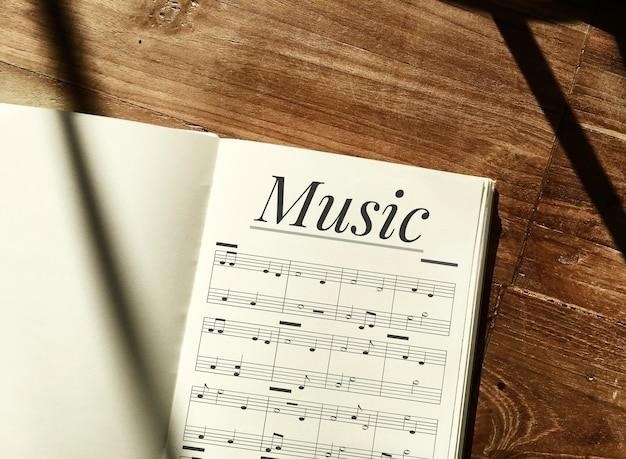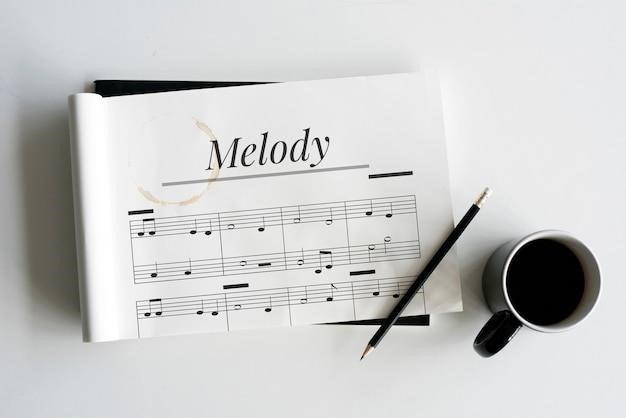Moonlight Sonata Piano Sheet Music⁚ A Comprehensive Guide
This guide explores everything you need to know about obtaining, learning, and performing Beethoven’s iconic Moonlight Sonata. From understanding its history and structure to finding free sheet music resources and learning resources, this guide will empower you to embark on your own musical journey with this timeless masterpiece.
History and Background
Ludwig van Beethoven’s Piano Sonata No. 14 in C-sharp minor, Op. 27 No. 2, commonly known as the “Moonlight Sonata,” is a cornerstone of the piano repertoire. Composed in 1801, the sonata was dedicated to Countess Giulietta Guicciardi, a pupil of Beethoven’s friend and fellow composer, Franz Gerhard Wegeler. The work’s title, “Moonlight Sonata,” was not given by Beethoven but emerged later, possibly inspired by the opening movement’s slow, dreamy character.
The sonata’s creation coincided with a period of profound change in Beethoven’s life. His hearing loss, which had begun in his late twenties, was becoming increasingly severe. This period also saw Beethoven’s burgeoning romantic feelings for Giulietta, who was later married to another man. The sonata’s emotional depth and dramatic character have been interpreted as reflecting these personal struggles and triumphs;
The Composition’s Structure
The Moonlight Sonata is structured in three distinct movements, each with its own unique character and tempo⁚
- Adagio sostenuto (C-sharp minor)⁚ The first movement is the most famous and instantly recognizable. It opens with a haunting, ethereal melody played in the left hand, while the right hand accompanies with soft, arpeggiated chords. The slow tempo and melancholic tone create an atmosphere of deep introspection.
- Allegretto (D-flat major)⁚ The second movement provides a contrast in mood and tempo. It is a graceful and playful scherzo with a lighter, more cheerful character. This movement serves as a moment of respite before the final movement’s dramatic conclusion.
- Presto agitato (C-sharp minor)⁚ The third movement is a whirlwind of energy and passion. It features rapid runs, dramatic chords, and a sense of urgency that drives the music towards a powerful finale.
The sonata’s structure allows for a journey through contrasting emotions, from the haunting beauty of the first movement to the playful energy of the second and the dramatic intensity of the finale.
Key Features of the Moonlight Sonata
The Moonlight Sonata is renowned for its distinctive musical features that have captivated audiences for centuries. These include⁚
- The Opening Theme⁚ The first movement’s iconic opening theme, played in the left hand, is characterized by its haunting, ethereal quality. The repeated, low-register notes create a sense of mystery and melancholy.
- Dynamic Contrast⁚ The sonata features dramatic shifts in dynamics, from the soft, whisper-like passages to the powerful, forceful sections. This interplay of volume creates a sense of emotional depth and tension.
- Use of Pedal⁚ Beethoven’s extensive use of the sustain pedal throughout the sonata creates a rich, resonant sound that washes over the listener. The pedal also blurs the lines between individual notes, giving the music a dreamy, ethereal quality.
- Chromaticism⁚ The frequent use of chromaticism, moving by half steps, adds to the sonata’s dramatic and expressive nature. It creates a sense of instability and tension, contributing to the emotional power of the music.
These features contribute to the Moonlight Sonata’s enduring popularity and its status as one of the most recognizable and beloved piano sonatas ever written.

Popularity and Influence
The Moonlight Sonata has enjoyed immense popularity since its composition, captivating audiences with its emotive power and technical brilliance. It has become a staple of the classical music repertoire, performed and enjoyed by musicians and listeners worldwide. This popularity has extended beyond the concert hall, with the sonata appearing in various forms of media, including film, television, and literature.
The sonata’s influence can be seen in the works of countless composers, who have drawn inspiration from its melodic themes, harmonic progressions, and overall emotional impact. It has served as a source of inspiration for countless arrangements, variations, and adaptations, ensuring its enduring legacy in the musical world.
The Moonlight Sonata’s popularity is a testament to its timeless appeal. It transcends cultural and generational boundaries, speaking to the universal emotions of love, loss, and longing that resonate with listeners across time.
Free Sheet Music Resources
The internet offers a wealth of free sheet music resources for those seeking to learn and play the Moonlight Sonata. These resources provide a convenient and accessible way to obtain the score without incurring any cost. While these resources may not always offer the highest quality printing or editing, they provide a valuable starting point for aspiring pianists.
Two popular websites that offer free sheet music for the Moonlight Sonata are Free-Scores.com and IMSLP. Free-Scores.com provides a wide selection of classical music scores, including various arrangements of the Moonlight Sonata. IMSLP, or the International Music Score Library Project, is a vast online repository of public domain musical scores, offering a comprehensive collection of Beethoven’s works, including the Moonlight Sonata.
These websites offer a valuable resource for pianists of all levels, providing readily available sheet music for those eager to explore and perform this iconic piece.
5.1. Free-Scores.com
Free-Scores.com is a comprehensive online resource that offers a wide range of free sheet music for various instruments and genres. For those seeking to learn the Moonlight Sonata, Free-Scores.com provides a valuable starting point. The website boasts a collection of classical music scores, including several arrangements of the Moonlight Sonata. While the quality of editing and printing may vary, Free-Scores.com offers a convenient and accessible way to obtain the score without any financial commitment.
Users can browse through various versions of the Moonlight Sonata, including different arrangements and interpretations. This allows pianists to choose the version that best suits their skill level and preferences. The website’s user-friendly interface allows for easy navigation and searching, making it simple to locate the desired sheet music. Free-Scores.com stands out as a reliable and valuable resource for those seeking free sheet music for the Moonlight Sonata.
5.2. IMSLP
IMSLP (International Music Score Library Project) is a treasure trove of public domain musical scores, offering a vast collection of classical music for free download. For those seeking the Moonlight Sonata, IMSLP provides a reliable and extensive resource. The website features multiple editions of the score, including the original version by Beethoven and various arrangements for different skill levels. IMSLP’s commitment to preserving and disseminating musical heritage ensures the availability of high-quality scores for aspiring musicians.
Navigating IMSLP is straightforward, with a search function that allows users to find specific pieces or composers. The website also offers a curated selection of popular classical works, including the Moonlight Sonata. The high-resolution scans of the scores ensure accurate representation of the original notation, providing a faithful rendition of Beethoven’s masterpiece. IMSLP’s comprehensive collection, user-friendly interface, and dedication to musical accessibility make it a valuable resource for anyone seeking free sheet music, particularly for the Moonlight Sonata.
Sheet Music for Different Skill Levels
The Moonlight Sonata, despite its reputation as a challenging piece, is available in arrangements suitable for a range of piano playing abilities. Beginners can find simplified versions that focus on key musical concepts and melodies, allowing them to experience the beauty of the Sonata while developing their piano skills. Intermediate players can delve into more complex arrangements, embracing the nuances of Beethoven’s composition. For advanced pianists, there are editions that offer a faithful representation of the original score, allowing for a nuanced and technically demanding interpretation.
These varied arrangements cater to different levels of proficiency, making the Moonlight Sonata accessible to a wider audience. Whether you’re a beginner just starting your musical journey or an experienced pianist seeking a challenging masterpiece, you can find a version of the Moonlight Sonata that aligns with your skill level. This diversity in sheet music options ensures that anyone can experience the magic of Beethoven’s iconic composition, regardless of their musical background.
Arranging for Other Instruments
While the Moonlight Sonata is inherently a piano piece, its enduring popularity has led to arrangements for a wide array of instruments, extending its reach beyond the keyboard. These arrangements often retain the essence of Beethoven’s composition, adapting its melodies and harmonies to the unique timbres and capabilities of different instruments. For instance, the Sonata’s haunting opening movement has been transcribed for solo violin, cello, flute, and even saxophone, allowing these instruments to capture the melancholic beauty of the original.

These arrangements not only offer new perspectives on the Moonlight Sonata but also provide opportunities for musicians who specialize in different instruments to engage with this iconic work. Whether it’s the soaring melodies of a violin or the warm tones of a cello, these adaptations allow musicians to explore the Sonata’s emotional depth and technical complexity through the lens of their chosen instrument. The Moonlight Sonata’s journey beyond the piano speaks to its universal appeal and enduring legacy as a timeless masterpiece.
Learning Resources
Learning the Moonlight Sonata can be a rewarding, yet challenging endeavor. Fortunately, a wealth of resources exists to guide aspiring pianists through this journey. Online platforms like YouTube offer numerous tutorials, ranging from beginner-friendly introductions to advanced masterclasses, providing a diverse range of perspectives and teaching styles. These videos often break down the Sonata’s intricate passages into manageable sections, offering detailed explanations of fingering, phrasing, and dynamics;
For a more structured approach, consider online courses or apps specifically designed for learning classical piano. These platforms often incorporate interactive exercises, performance feedback, and personalized learning paths, providing a comprehensive and engaging experience. Additionally, local music schools or private instructors can offer tailored lessons, allowing students to receive individualized guidance and feedback. Whether through online resources or traditional methods, the path to mastering the Moonlight Sonata is paved with numerous learning opportunities, allowing pianists of all levels to unlock the secrets of this musical masterpiece.
Downloading and Printing Sheet Music
Once you’ve chosen your preferred source for Moonlight Sonata sheet music, the process of downloading and printing is typically straightforward. Most websites offering free sheet music provide clear download buttons or links. These files are usually in PDF format, making them easily printable on standard home printers. Ensure your printer settings are configured for high-quality printing to preserve the clarity of the musical notation.
Some websites might also offer MIDI files, which contain digital representations of the musical score. These files can be opened and played back on computer programs or dedicated MIDI devices. However, for physical practice, printed sheet music remains the most common and versatile option. When printing, consider using heavier paper or cardstock for durability, especially if you plan to use the sheet music frequently. A clear and easily readable score will enhance your learning experience and contribute to a more enjoyable and successful practice session.
Performance Considerations
When approaching a performance of Moonlight Sonata, certain considerations can elevate your interpretation. The first movement, “Adagio sostenuto,” is renowned for its ethereal and melancholic character. Pay close attention to the dynamics, ensuring a delicate and nuanced touch, especially in the opening theme. The use of the sustain pedal is crucial, as it creates a sense of legato and ethereal atmosphere. For the second movement, “Allegretto,” a shift in mood occurs. Embrace a more playful and lyrical approach, allowing the contrasting sections to unfold with clarity.
The final movement, “Presto agitato,” demands technical proficiency and dramatic intensity. Master the rapid runs and complex chord progressions, ensuring a sense of urgency and momentum. Throughout the entire sonata, be mindful of the tempo markings and strive for a balanced and controlled performance. Remember, Moonlight Sonata is a journey of emotions, and your performance should reflect the subtle shifts in mood and character within the music. Practice with intention and attention to detail, and your interpretation will resonate with the timeless beauty of this iconic composition.

No Responses